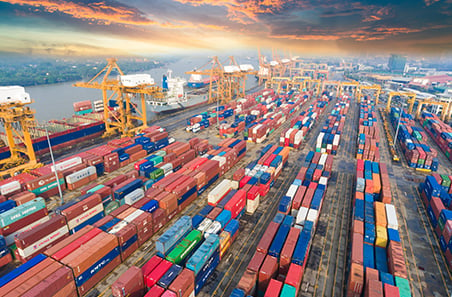
DFAT Portal
Access under Australia’s FTAs
Improved market access, and the successful defence of existing gains, will be critical in achieving industry’s 2030 goal of improving economic resilience.
Fortunately, Australian red meat and livestock has access to many export markets, thanks to robust integrity systems, an unrivalled disease-free status, and a track record by the Australian industry in partnership with the Government in perusing preferential trade reform.
However, a large number of Australia's overseas markets remain subject to entry barriers. These impediments to trade are imposed in many forms. Border protection measures, including tariffs and quotas, are the most obvious. However, non-tariff barriers and technical imposts are also major issues. While Australian exports have benefited from the reduction in tariffs over the last three decades, non-tariff barriers can often prohibit the industry from fully realising those gains.
Red Meat 2030 outlines industry’s goals in relation to market access:
In terms of preferential access, the Australian red meat industry’s current priority is to secure improved import regimes through ongoing trade negotiations with the European Union and India.
When it comes to non-tariff reform, removing impediments in the Middle East, China and South East Asia are the priority.
|
Market |
Agreement(s) |
Applied tariff (%) |
Safeguard / quota and |
|
Canada |
CPTPP |
0 |
- |
|
Chile |
A-CFTA / CPTPP |
0 |
- |
|
China |
ChAFTA / RCEP |
0 |
Safeguard: 208,307t; 12% (25% for carcasses) |
|
European Union |
WTO |
20% (Hilton HQB), 0% (shared GFB) |
Quotas: 3,389t (Hilton HQB); 12,400t (shared GFB); 12.8% + up to 3 €/kg |
|
Gulf Cooperation Council |
WTO / A-UAE CEPA |
0-5% |
- |
|
Hong Kong |
A-HKFTA |
0 |
- |
|
India |
WTO |
30% |
- |
|
Indonesia |
AANZFTA / IA-CEPA |
0 |
- |
|
Japan |
JAEPA / CPTPP / RCEP |
21.6% (from 1 April) |
Safeguard: 672,000t (CPTPP); 30% (from 1 April) |
|
Korea |
KAFTA / RCEP |
8% |
Safeguard: 192.206t; 24% |
|
Malaysia |
MAFTA / AANZFTA / CPTPP |
0 |
- |
|
Mexico |
CPTPP |
4-5% |
- |
|
New Zealand |
CER / AANZFTA / CPTPP / RCEP |
0 |
- |
|
Peru |
CPTPP / PAFTA |
0-5% |
- |
|
Philippines |
AANZFTA |
0 |
- |
|
Russia (NB current ban on beef imports) |
WTO |
15% |
Shared quotas: 11,000t (chilled); 407,000t (frozen); 50% |
|
Singapore |
SAFTA / AANZFTA / CPTPP / RCEP |
0 |
- |
|
South Africa |
WTO |
40% or 240c/kg |
- |
|
Taiwan |
WTO |
NT $10.5/kg |
- |
|
Thailand |
TAFTA / AANZFTA / RCEP |
0 |
- |
|
United Kingdom |
WTO / A-UKFTA |
0-20% |
WTO Quota: 3,761t; FTA Quota: 51,667t; 12.0% + up to 2.6 £/kg |
|
United States |
AUSFTA |
10% |
0% under AUSFTA; 10% baseline ‘US Liberation Day’ tariff |
|
Vietnam |
AANZFTA / CPTPP / RCEP |
0 |
- |
|
Market |
Agreement(s) |
Applied tariff (%) |
Quota and out-of-quota tariff (%) |
|
Canada |
CPTPP |
0 |
- |
|
Chile |
A-CFTA / CPTPP |
0 |
- |
|
China |
ChAFTA |
0 |
- |
|
European Union |
WTO |
0 |
Quota: 5,851t; |
|
Gulf Cooperation Council |
WTO / A-UAE CEPA |
0-5% |
- |
|
Hong Kong |
A-HKFTA |
0 |
- |
|
India |
AI-ECTA |
0 |
- |
|
Indonesia |
AANZFTA/ IA-CEPA |
0 |
- |
|
Japan |
JAEPA / CPTPP |
0 |
- |
|
Korea |
KAFTA |
0 |
- |
|
Malaysia |
MAFTA / AANZFTA / CPTPP |
0 |
- |
|
Mexico |
CPTPP |
0 |
- |
|
New Zealand |
CER / AANZFTA / CPTPP |
0 |
- |
|
Papua New Guinea |
WTO |
0 |
- |
|
Peru |
CPTPP / PAFTA |
0 |
- |
|
Philippines |
AANZFTA |
0 (5% for goatmeat) |
- |
|
Russia |
WTO |
15% |
- |
|
Singapore |
SAFTA / AANZFTA / CPTPP |
0 |
- |
|
South Africa |
WTO |
40% or 200c/kg |
- |
|
Taiwan |
WTO |
15% or NT $11.3/kg |
- |
|
Thailand |
TAFTA / AANZFTA |
0 |
- |
|
United Kingdom |
WTO / A-UKFTA |
0 |
WTO Quota: 13,335t; 12.0% + up to 2.6 £/kg; FTA Quota: 36,111t |
|
United States |
AUSFTA |
10% |
0% under AUSFTA; 10% baseline ‘US Liberation Day’ tariff |
|
Vietnam |
AANZFTA / CPTPP / RCEP |
0 |
- |
Note: as tariff rates and quotas can alter, reference should also be made to DFAT’s FTA Portal as well as the tariff schedules available from the relevant authority in the country of interest.
Acronyms:
AANZFTA: ASEAN-Australia-New Zealand Free Trade Area; AI ECTA: Australia-India Economic Cooperation and Trade Agreement; A-UKFTA: Australia-United Kingdom Free Trade Agreement; A-UAE CEPA: Australia United Arab Emirates Comprehensive Economic Partnership Agreement; AUSFTA: Australia-United States Free Trade Agreement; CER: Australia-New Zealand Closer Economic Relations; CPTPP: Comprehensive and Progressive Trans-Pacific Partnership; ChAFTA: China-Australia Free Trade Agreement; A-HKFTA: Australia-Hong Kong Free Trade Agreement; IA-CEPA: Indonesia-Australia Economic Partnership Agreement; JAEPA: Japan-Australia Economic Partnership Agreement; KAFTA: Korea-Australia Free Trade Agreement; MAFTA: Malaysia-Australia Free Trade Agreement; PAFTA: Peru-Australia Free Trade Agreement; RCEP: Regional Comprehensive Economic Partnership; SAFTA: Singapore-Australia Free Trade Agreement; TAFTA: Thailand-Australia Free Trade Agreement; WTO: World Trade Organisation.
As a major exporting industry, changes in access to overseas markets affect the profitability of both individual livestock producers and meat processors. Access to a wide array of global markets allows Australian exporters to maximise the value of each carcase and reduce the risk of being overly reliant on any one buyer. Dynamic international market conditions require an ongoing effort to defend access and, where possible, secure improvements to export conditions via trade reform.
MLA's role in market access
MLA’s market access program, co-funded by producer levies and processor contributions, works alongside industry and government to defend and maintain existing favourable access conditions, position Australia positively in trade negotiations and assist with the alleviation of non-tariff (technical) trade barriers via in-market representation and research.
MLA’s contribution is led by staff in Sydney, and via our overseas offices in Washington DC, London, Dubai, Beijing, Tokyo, Seoul, Singapore and Jakarta, coupled with our network of representatives in South East Asia.
Broadly speaking, MLA has a trade advocacy role.
Access under Australia’s FTAs
The status on FTAs under negotiation
DAFF’s database of importing country requirements


